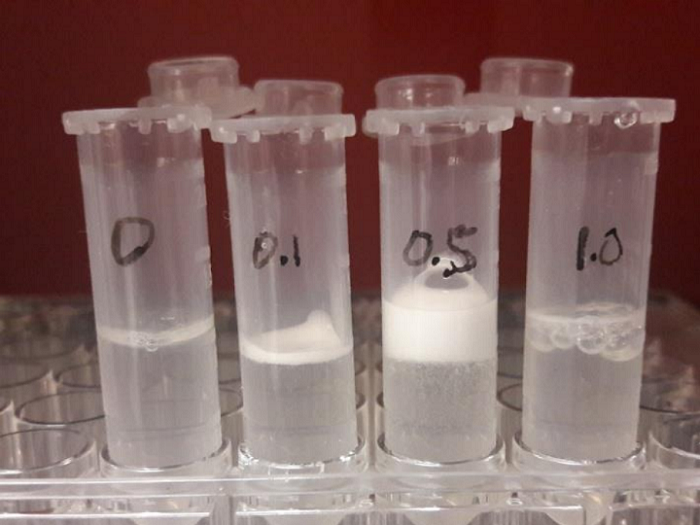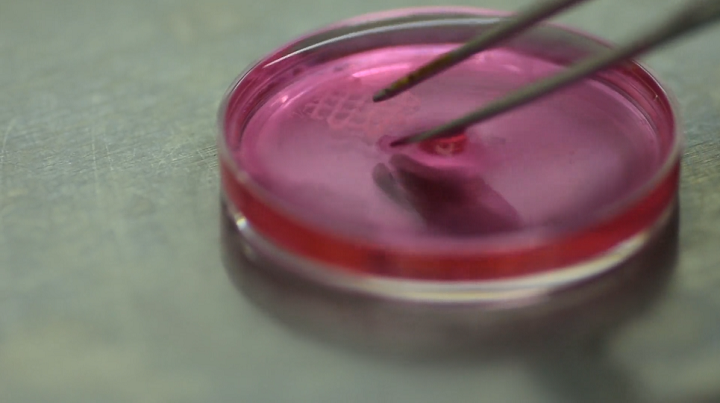Tissue engineering or regeneration is the process of improving upon or replacing biological tissues by combining cells and other materials with the optimal chemical and physiological conditions in order to build scaffolds upon which new viable tissue can form. We’ve seen many examples of 3D printing being used to accomplish this task. The potential to engineer new tissues this way provides an answer to organ transplant shortages and applications in drug discovery.
However, to become viable tissues, these cells need oxygen delivered to them via blood vessels, which, in transplanted tissue, can take several days to grow. But a collaborative group of researchers is working on a solution: an oxygen-releasing bioink that can deliver this all-important element to the cells in 3D bioprinted tissues. This allows the cells to survive while they’re waiting for blood vessels to finish growing.

Heart cells in a bioink (L) without oxygen support and (R) with oxygen-releasing capabilities. Live cells are stained green, dead cells red. (Image: Khademhosseini Lab)
The team of researchers—from UCLA, Kocaeli University in Turkey, the Terasaki Institute for Biomedical Innovation (TIBI) in California, Sharif University of Technology in Iran, Erciyes University in Turkey, Université de Lorraine in France, and the University of Iowa—recently published a paper, “3D Bioprinting of Oxygenated Cell-Laden Gelatin Methacryloyl Constructs,” in Advanced Healthcare Materials about their work.
The abstract states, “Cell survival during the early stages of transplantation and before new blood vessels formation is a major challenge in translational applications of 3D bioprinted tissues. Supplementing oxygen (O2) to transplanted cells via an O2 generating source such as calcium peroxide (CPO) is an attractive approach to ensure cell viability. Calcium peroxide also produces calcium hydroxide that reduces the viscosity of bioinks, which is a limiting factor for bioprinting. Therefore, adapting this solution into 3D bioprinting is of significant importance. In this study, a gelatin methacryloyl (GelMA) bioink that is optimized in terms of pH and viscosity is developed. The improved rheological properties lead to the production of a robust bioink suitable for 3D bioprinting and controlled O2 release. In addition, O2 release, bioprinting conditions, and mechanical performance of hydrogels having different CPO concentrations are characterized. As a proof of concept study, fibroblasts and cardiomyocytes are bioprinted using CPO containing GelMA bioink. Viability and metabolic activity of printed cells are checked after 7 days of culture under hypoxic condition. The results show that the addition of CPO improves the metabolic activity and viability of cells in bioprinted constructs under hypoxic condition.”
In order to enhance the physical and chemical properties of their oxygen-generating gelatin methacryloyl (GelMA) bioink, the team performed extensive testing, and found that enough oxygen was delivered to the cells to tide the developing tissue structures over until the blood vessels were finished developing. Once that happened, the vessels could take over the delivery of oxygen. Even then, the bioink can still help by providing extra support in order to enhance the growth and regeneration of more new tissue.
“By delivering oxygen to the implanted cells, we would be able to improve the tissue functionality and integration to the host tissue,” explained Samad Ahadian, PhD, the lead investigator for the TIBI team. “A similar approach can be used to make functional tissues with improved survival for drug screening applications and pathophysiological studies within a long period of time.”
Additionally, the researchers conducted experiments on tissue constructs that had two types of cells, including muscle cells and cardiac cells, and reported that using the new bioink resulted in some “positive effects.”
(Source: Nanowerk News)
Subscribe to Our Email Newsletter
Stay up-to-date on all the latest news from the 3D printing industry and receive information and offers from third party vendors.
You May Also Like
Gorilla Sports GE’s First 3D Printed Titanium Cast
How do you help a gorilla with a broken arm? Sounds like the start of a bad joke a zookeeper might tell, but it’s an actual dilemma recently faced by...
Nylon 3D Printed Parts Made More Functional with Coatings & Colors
Parts 3D printed from polyamide (PA, Nylon) 12 using powder bed fusion (PBF) are a mainstay in the additive manufacturing (AM) industry. While post-finishing processes have improved the porosity of...
$25M to Back Sintavia’s Largest Expansion of Metal 3D Printing Capacity Since 2019
Sintavia, the digital manufacturing company specializing in mission-critical parts for strategic sectors, announced a $25 million investment to increase its production capacity, the largest expansion to its operations since 2019....
Velo3D Initiates Public Offering in a Bid to Strengthen Financial Foundations and Drive Future Growth
Velo3D (NYSE: VLD) has been among a number of publicly traded 3D printing firms that have attempted to weather the current macroeconomic climate. After posting a challenging financial report for 2023,...

































